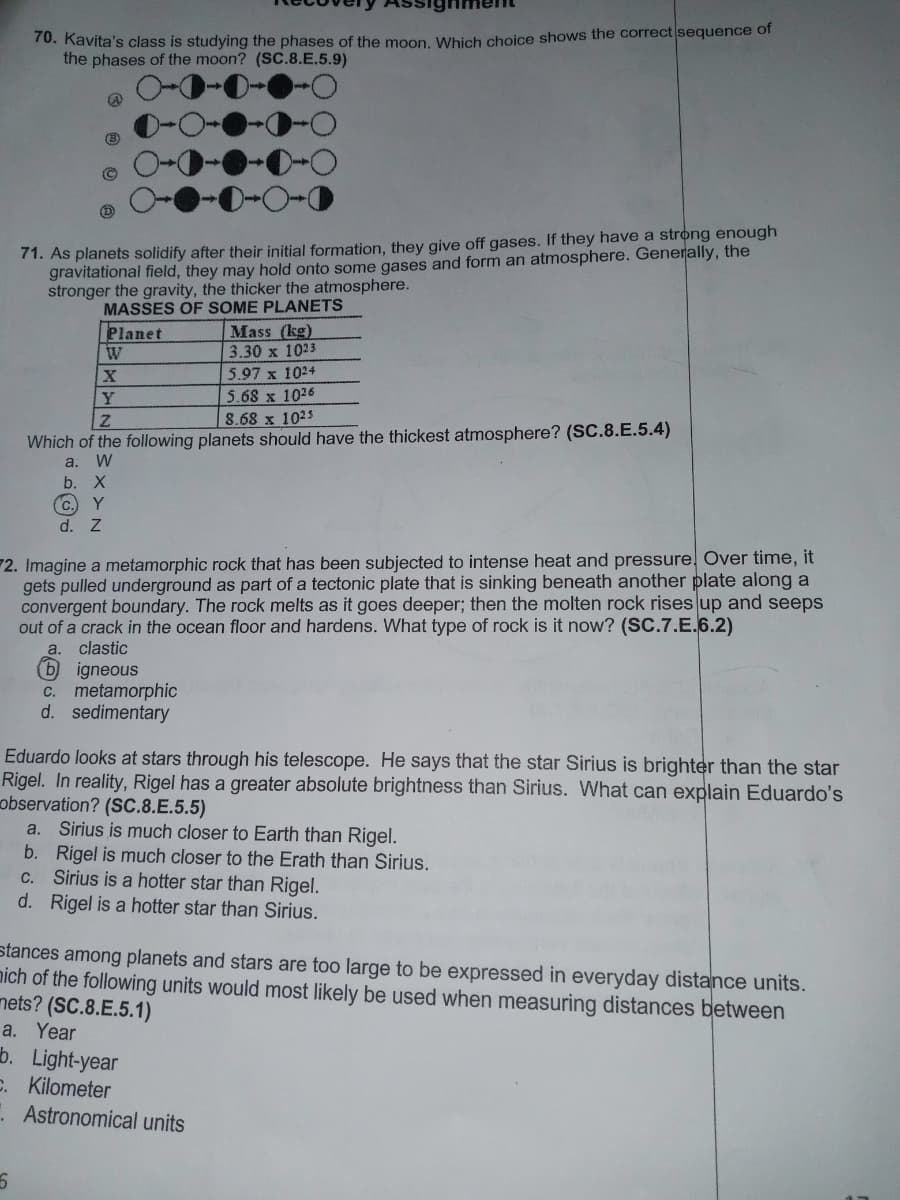70. Kavita's class is studying the phases of the moon, Which choice shows the correct sequence of the phases of the moon? (SC.8.E.5.9) D-O
70. Kavita's class is studying the phases of the moon, Which choice shows the correct sequence of the phases of the moon? (SC.8.E.5.9) D-O
Applications and Investigations in Earth Science (9th Edition)
9th Edition
ISBN:9780134746241
Author:Edward J. Tarbuck, Frederick K. Lutgens, Dennis G. Tasa
Publisher:Edward J. Tarbuck, Frederick K. Lutgens, Dennis G. Tasa
Chapter1: The Study Of Minerals
Section: Chapter Questions
Problem 1LR
Related questions
Question
Number 70

Transcribed Image Text:70. Kavita's class is studying the phases of the moon Which choice shows the correct sequence of
the phases of the moon? (SC.8.E.5.9)
71. As planets solidify after their initial formation, they give off gases. If they have a strong enough
gravitational field, they may hold onto some gases and form an atmosphere. Generally, the
stronger the gravity, the thicker the atmosphere.
MASSES OF SOME PLANETS
Mass (kg)
3.30 x 1023
5.97 x 1024
Planet
5.68 x 1026
8.68 x 1025
Y.
Which of the following planets should have the thickest atmosphere? (SC.8.E.5.4)
a. W
b. X
c. Y
d. Z
72. Imagine a metamorphic rock that has been subjected to intense heat and pressure. Over time, it
gets pulled underground as part of a tectonic plate that is sinking beneath another plate along a
convergent boundary. The rock melts as it goes deeper; then the molten rock rises up and seeps
out of a crack in the ocean floor and hardens. What type of rock is it now? (SC.7.E.6.2)
clastic
b igneous
C. metamorphic
d. sedimentary
a.
Eduardo looks at stars through his telescope. He says that the star Sirius is brighter than the star
Rigel. In reality, Rigel has a greater absolute brightness than Sirius. What can explain Eduardo's
observation? (SC.8.E.5.5)
a. Sirius is much closer to Earth than Rigel.
b. Rigel is much closer to the Erath than Sirius.
C. Sirius is a hotter star than Rigel.
d. Rigel is a hotter star than Sirius.
stances among planets and stars are too large to be expressed in everyday distance units.
nich of the following units would most likely be used when measuring distances between
nets? (SC.8.E.5.1)
a. Year
b. Light-year
C. Kilometer
. Astronomical units
Expert Solution
This question has been solved!
Explore an expertly crafted, step-by-step solution for a thorough understanding of key concepts.
This is a popular solution!
Trending now
This is a popular solution!
Step by step
Solved in 2 steps

Recommended textbooks for you

Applications and Investigations in Earth Science …
Earth Science
ISBN:
9780134746241
Author:
Edward J. Tarbuck, Frederick K. Lutgens, Dennis G. Tasa
Publisher:
PEARSON

Exercises for Weather & Climate (9th Edition)
Earth Science
ISBN:
9780134041360
Author:
Greg Carbone
Publisher:
PEARSON

Environmental Science
Earth Science
ISBN:
9781260153125
Author:
William P Cunningham Prof., Mary Ann Cunningham Professor
Publisher:
McGraw-Hill Education

Applications and Investigations in Earth Science …
Earth Science
ISBN:
9780134746241
Author:
Edward J. Tarbuck, Frederick K. Lutgens, Dennis G. Tasa
Publisher:
PEARSON

Exercises for Weather & Climate (9th Edition)
Earth Science
ISBN:
9780134041360
Author:
Greg Carbone
Publisher:
PEARSON

Environmental Science
Earth Science
ISBN:
9781260153125
Author:
William P Cunningham Prof., Mary Ann Cunningham Professor
Publisher:
McGraw-Hill Education

Earth Science (15th Edition)
Earth Science
ISBN:
9780134543536
Author:
Edward J. Tarbuck, Frederick K. Lutgens, Dennis G. Tasa
Publisher:
PEARSON

Environmental Science (MindTap Course List)
Earth Science
ISBN:
9781337569613
Author:
G. Tyler Miller, Scott Spoolman
Publisher:
Cengage Learning

Physical Geology
Earth Science
ISBN:
9781259916823
Author:
Plummer, Charles C., CARLSON, Diane H., Hammersley, Lisa
Publisher:
Mcgraw-hill Education,